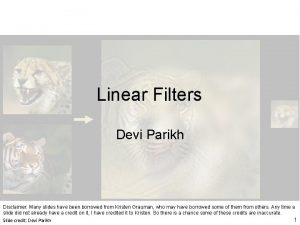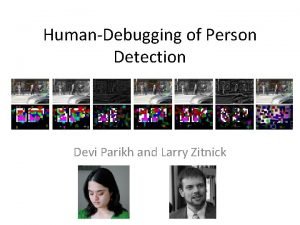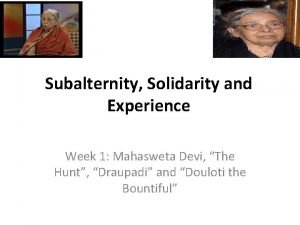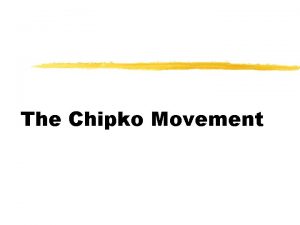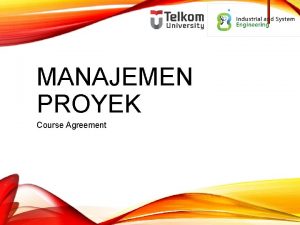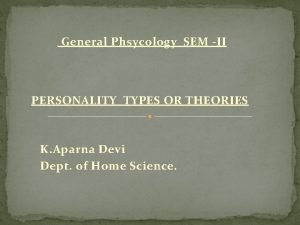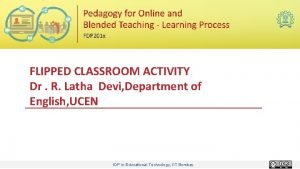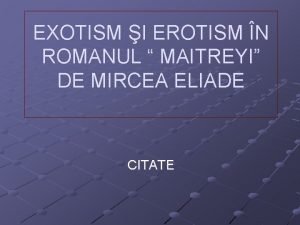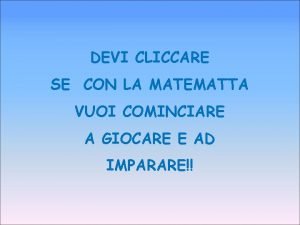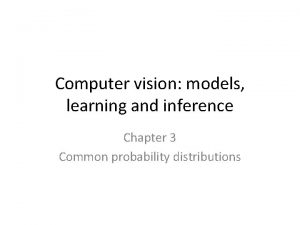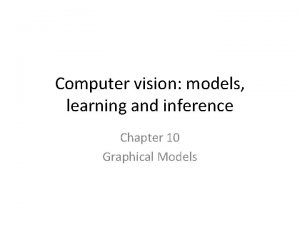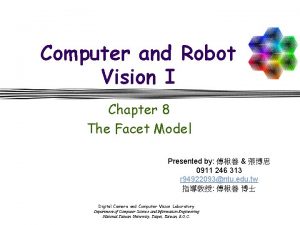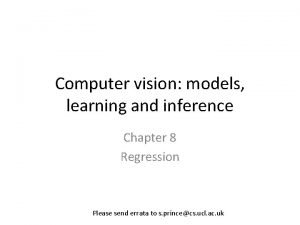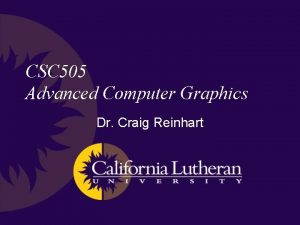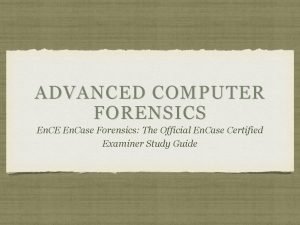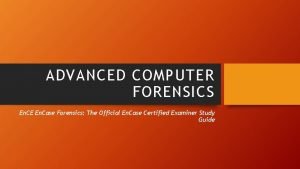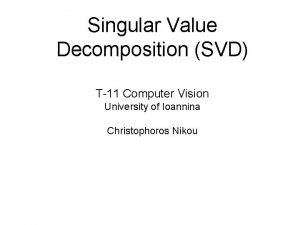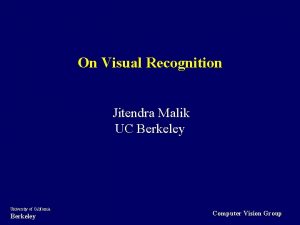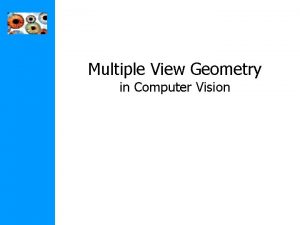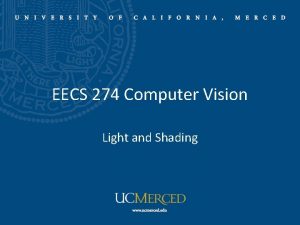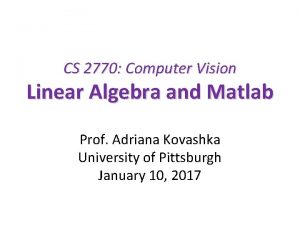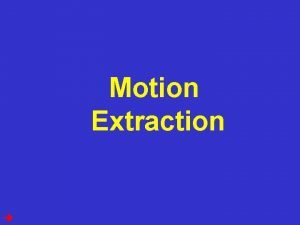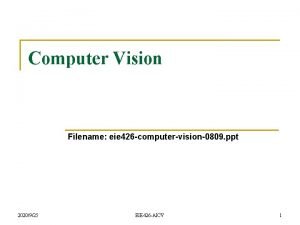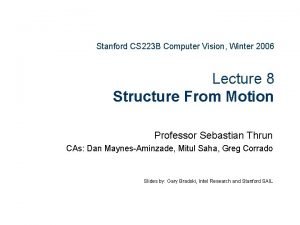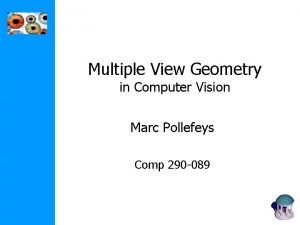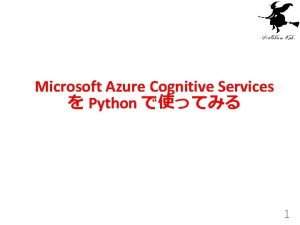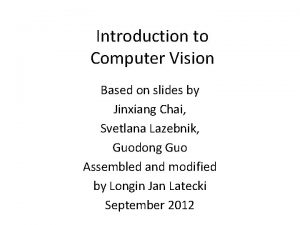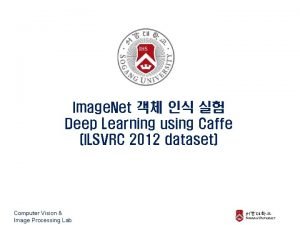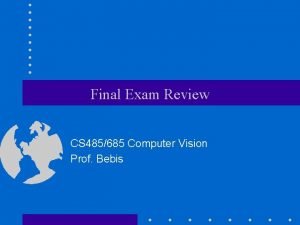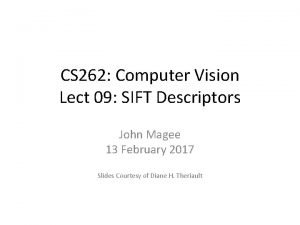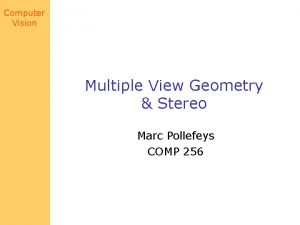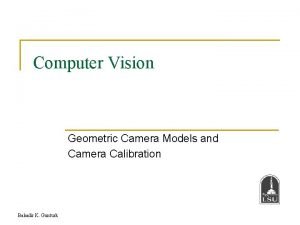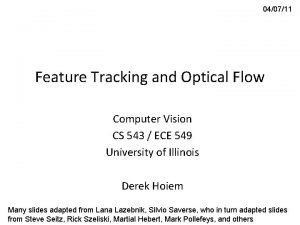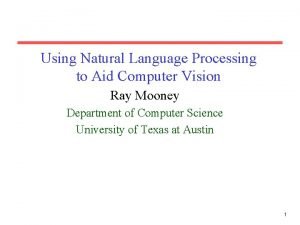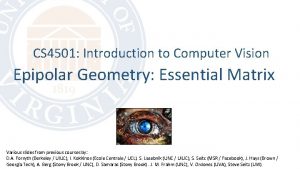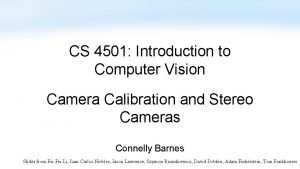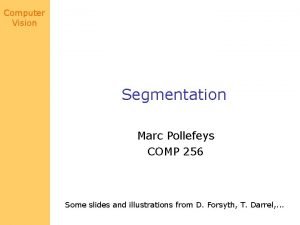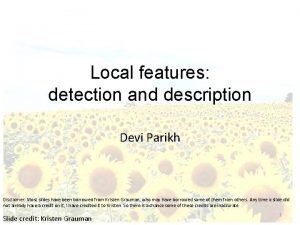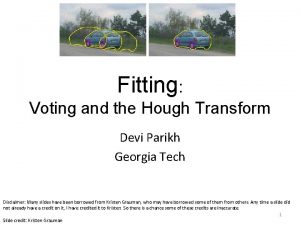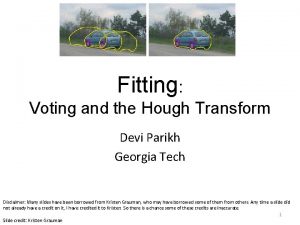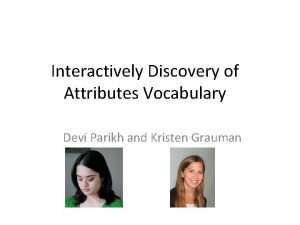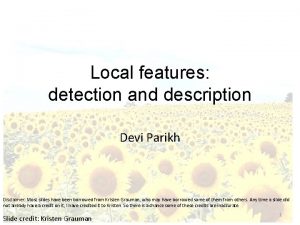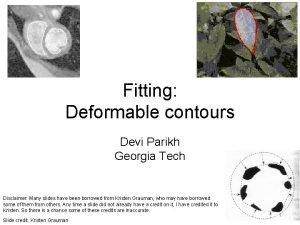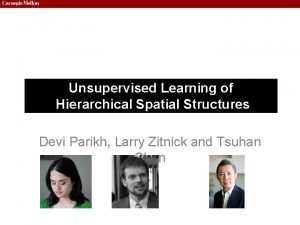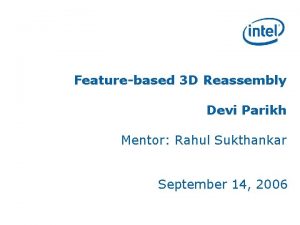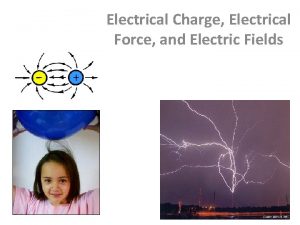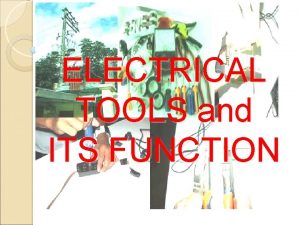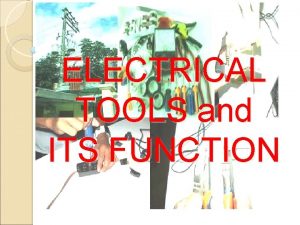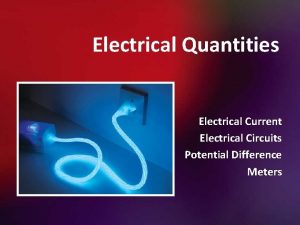Advanced Computer Vision Devi Parikh Electrical and Computer





































![Expectations • Paper reviews each class [25%] • Leading discussion (~ twice) on papers Expectations • Paper reviews each class [25%] • Leading discussion (~ twice) on papers](https://slidetodoc.com/presentation_image_h/cc975a2a907cd74fd6b3fe66eadd4bfc/image-38.jpg)










![Project timeline • Project proposals (1 page) [25%] – March 1 st • Final Project timeline • Project proposals (1 page) [25%] – March 1 st • Final](https://slidetodoc.com/presentation_image_h/cc975a2a907cd74fd6b3fe66eadd4bfc/image-49.jpg)






- Slides: 55

Advanced Computer Vision Devi Parikh Electrical and Computer Engineering

Plan for today • Topic overview • Introductions • Course overview: – Logistics – Requirements • Placing this course in context of others – Plan for next lecture • Please interrupt at any time with questions or comments

Computer Vision • Automatic understanding of images and video – Computing properties of the 3 D world from visual data (measurement) – Algorithms and representations to allow a machine to recognize objects, people, scenes, and activities. (perception and interpretation) – Algorithms to mine, search, and interact with visual data (search and organization) Kristen Grauman

What does recognition involve? Fei-Fei Li

Detection: are there people?

Activity: What are they doing?

Object categorization mountain tree building banner street lamp vendor people

Instance recognition Potala Palace A particular sign

Scene and context categorization • outdoor • city • …

Attribute recognition gray made of fabric crowded flat

Why recognition? • Recognition a fundamental part of perception – e. g. , robots, autonomous agents • Organize and give access to visual content – Connect to information – Detect trends and themes • Where are we now? Kristen Grauman

We’ve come a long way…

We’ve come a long way…

We’ve come a long way…

Posing visual queries Yeh et al. , MIT Belhumeur et al. Kristen Grauman Kooaba, Bay & Quack et al.

Exploring community photo collections Snavely et al. Kristen Grauman Simon & Seitz

Dubrovnik Auto. Tagger: Yunpeng Li, Noah Snavely, Dan Huttenlocher and Pascal Fua 17 Slide credit: Devi Parikh

Autonomous agents able to detect objects Kristen Grauman http: //www. darpa. mil/grandchallenge/gallery. asp

We’ve come a long way… Fischler and Elschlager, 1973

We’ve come a long way…

Challenges

Challenges: robustness Illumination Occlusions Kristen Grauman Object pose Intra-class appearance Clutter Viewpoint

Challenges: context and human experience Context cues Kristen Grauman

Challenges: context and human experience Context cues Kristen Grauman Function Dynamics Video credit: J. Davis

Challenges: scale, efficiency • Half of the cerebral cortex in primates is devoted to processing visual information • ~20 hours of video added to You. Tube per minute • ~5, 000 new tagged photos added to Flickr per minute • Thousands to millions of pixels in an image • 30+ degrees of freedom in the pose of articulated objects (humans) • 3, 000 -30, 000 human recognizable object categories Kristen Grauman

Challenges: learning with minimal supervision More Less Un mu lab lti ele pl d, e ob je c ts Kristen Grauman Cl so asse me s clu labe tte led , r Cr pa opp lab rts a ed t ele nd o o d cla bje sse ct, s

Slide from Pietro Perona, 2004 Object Recognition workshop

Slide from Pietro Perona, 2004 Object Recognition workshop

Inputs in 1963… L. G. Roberts, Machine Perception of Three Dimensional Solids, Ph. D. thesis, MIT Department of Electrical Engineering, 1963. Kristen Grauman

… and inputs today Personal photo albums Surveillance and security Movies, news, sports Medical and scientific images Slide credit; L. Lazebnik

… and inputs today 350 mil. photos, 1 mil. added daily 1. 6 bil. images indexed as of summer 2005 916, 271 titles 10 mil. videos, 65, 000 added daily Understand organize and index all this data!! Images on the Web Satellite imagery Movies, news, sports City streets Slide credit; L. Lazebnik

Introductions • • Devi Parikh Ph. D. , Carnegie Mellon University, 2009 Research Assistant Professor, TTI-Chicago, 2013 Assistant Professor, ECE, Virginia Tech

Introductions • • • Which program are you in? How far along? Have you taken a computer vision course before? Have you taken a machine learning course before? What are you hoping to get out of this class?

This course • ECE 6554 • TR 5: 00 pm to 6: 15 pm • Lavery Hall Room 345 • Course webpage: https: //filebox. ece. vt. edu/~S 16 ECE 6554/

This course • Focus on more advanced techniques and ideas in computer vision • Presented in research papers • High-level recognition problems, innovative applications.

Goals • • Understand state-of-the-art approaches Analyze and critique current approaches Identify interesting open questions Present clearly and methodically

Official Learning Objectives • Describe state-of-the-art approaches in object recognition and scene understanding • Discuss tools from other fields (e. g. , machine learning) that are frequently used to solve computer vision problems • Implement two approaches to address important problems in computer vision • Discuss and critique research papers in computer vision • Identify open research questions in computer vision
![Expectations Paper reviews each class 25 Leading discussion twice on papers Expectations • Paper reviews each class [25%] • Leading discussion (~ twice) on papers](https://slidetodoc.com/presentation_image_h/cc975a2a907cd74fd6b3fe66eadd4bfc/image-38.jpg)
Expectations • Paper reviews each class [25%] • Leading discussion (~ twice) on papers [15%] • Presentations (~ once) [25%] – Present topic – Papers and background reading • Project [35%] No “Assignments”, Exams, etc.

Prerequisites • Course in computer vision • Courses in machine learning is a plus

Paper reviews • For each class – Review one paper • Email me reviews by noon (12: 00 pm) the day of the class – firstname_lastname_MM_DD. pdf – I will grade a random subset in detail • Skip reviews the classes you are presenting or leading discussion • Late reviews will not be accepted • Will drop three lowest grades on reviews

Paper review guidelines • One page • Detailed review: – – – – Brief (2 -3 sentences) summary Main contribution Strengths? Weaknesses? How convincing are the experiments? Suggestions to improve them? Extensions? Applications? Additional comments, unclear points Relationships observed between the papers we are reading • Most interesting thought • Write in your own words • Write well, proof read

Leading Discussion • ~ One of you will be assigned to argue for the paper • ~ One of you will be assigned to argue against the paper • Come prepared with 5 points

Presentation guidelines • IMPORTANT: Don’t present papers – present the topic! • Do a lit review and look at background papers (e. g. “seeds / pointers for presenters”), and also more recent work. • Well-organized talk, 30 minutes

Presentation guidelines • What to cover? – Topic overview, motivation – One or two papers in details • • • Problem overview, motivation Algorithm explanation, technical details Experimental set up, results Strengths, weaknesses, extensions NOT the paper the class has read. – Any commonalities, important differences between techniques covered in the papers. • A demo / experiment would be great • See class webpage for more details.

Experiments • Implement/download code for a main idea in the paper and evaluate it: – Experiment with different types of training/testing data sets – Evaluate sensitivity to important parameter settings – Show an example to analyze a strength/weakness of the approach – Show qualitative and quantitative results

Tips • Look up papers and authors. Their webpage may have data, code, slides, videos, etc. – Make sure talk flows well and makes sense as a whole. – Cite ALL sources. • Don’t forget the high-level picture. • Give a very clear and well-organized and thought out talk. • Will interrupt if something is not clear

Tips • Make sure you are saying everything we need to know to understand what you are saying. • Make sure you know what you are talking about. • Think about your audience. • Make your talks visual, animated (images, video, not lots of text).

Projects Possibilities: – Extension of a technique studied in class – Analysis and empirical evaluation of an existing technique – Comparison between two approaches – Design and evaluate a novel approach – Be creative! Can work with a partner
![Project timeline Project proposals 1 page 25 March 1 st Final Project timeline • Project proposals (1 page) [25%] – March 1 st • Final](https://slidetodoc.com/presentation_image_h/cc975a2a907cd74fd6b3fe66eadd4bfc/image-49.jpg)
Project timeline • Project proposals (1 page) [25%] – March 1 st • Final presentations [40%] – April 19 th to 26 th • Project video (1 minute) [35%] – April 28 thth

Implementation • Use any language / platform you like • No support for code / implementation issues will be provided

Miscellaneous • Best presentation, best project and best discussion prizes! – We will vote – Dinner • Feedback welcome and useful

Coming up • Read the class webpage – Schedule is up – Tentative, especially because of likely snow days • Select 6 dates (topics) you would like to present – Sign up sheet shows how many people have already signed up for a topic – Select those that have fewer selections – “Bonus” for presenters next week. – Probability of dropping class? • I will send pointers to good presentations, reviews, etc. Already on class webpage.

Context • Intro to computer vision – Intro to machine learning • Course last semester on Deep Learning for Perception: – https: //computing. ece. vt. edu/~f 15 ece 6504/ – This course is complementary to it • Ram’s presentation on Thursday – Individual presenters will touch on state-of-the -art in each

Each Lecture • ~ 20 minute discussion on paper we read – Led by two students: “for” and “against” • ~ 30 minute presentation on topic • ~ 25 minutes for questions, interruptions, unplanned discussions

Questions? See you Thursday!
 Devi parikh
Devi parikh Devi parikh
Devi parikh Devi
Devi Dr chetan parikh
Dr chetan parikh Structured light
Structured light Draupadi by mahasweta devi questions and answers
Draupadi by mahasweta devi questions and answers Io devo tu devi
Io devo tu devi Srimati devi indira
Srimati devi indira Chandi prasad bhatt quotes
Chandi prasad bhatt quotes Aditi devi bhava
Aditi devi bhava Devi pratami
Devi pratami Sadyojatam prapadyami
Sadyojatam prapadyami Digilogous
Digilogous Devi personality type
Devi personality type R latha devi
R latha devi Citate din maitreyi
Citate din maitreyi Ic ambrogio lorenzetti
Ic ambrogio lorenzetti Devi cliccare
Devi cliccare Shinta devi
Shinta devi Klipsch school of electrical and computer engineering
Klipsch school of electrical and computer engineering Tum department of electrical and computer engineering
Tum department of electrical and computer engineering Computer vision models learning and inference
Computer vision models learning and inference Mathematical foundations of computer graphics and vision
Mathematical foundations of computer graphics and vision Computer vision models learning and inference
Computer vision models learning and inference Computer vision: models, learning, and inference pdf
Computer vision: models, learning, and inference pdf Computer and robot vision
Computer and robot vision Computer vision: models, learning, and inference
Computer vision: models, learning, and inference Review of fundamentals of cpu
Review of fundamentals of cpu Advanced topics in computer science
Advanced topics in computer science Craig reinhart
Craig reinhart Advanced computer forensics
Advanced computer forensics Fastbloc
Fastbloc 16-385 computer vision
16-385 computer vision Kalman filter computer vision
Kalman filter computer vision Svd computer vision
Svd computer vision Berkeley computer vision
Berkeley computer vision Multiple view geometry
Multiple view geometry Face detection viola jones
Face detection viola jones Radiometry in computer vision
Radiometry in computer vision Linear algebra for computer vision
Linear algebra for computer vision Computer vision
Computer vision Computer vision ppt
Computer vision ppt Computer vision stanford
Computer vision stanford Quadrifocal
Quadrifocal Python cognitive services
Python cognitive services Computer vision slides
Computer vision slides Ilsvrc 2012 dataset
Ilsvrc 2012 dataset Computer vision final exam
Computer vision final exam Sift computer vision
Sift computer vision Multiple view geometry in computer vision solution manual
Multiple view geometry in computer vision solution manual Coordinate rotation matrix
Coordinate rotation matrix Aperture problem computer vision
Aperture problem computer vision Computer vision vs nlp
Computer vision vs nlp Epipolar geometry computer vision
Epipolar geometry computer vision Computer vision camera calibration
Computer vision camera calibration Computer vision
Computer vision

